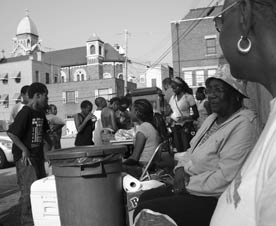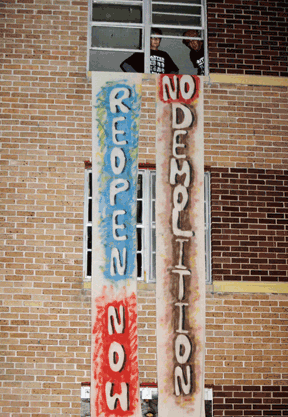In April 1968, angry students, faculty, and community members occupied several Columbia University buildings in response to the university’s plans to build a gymnasium on land taken from nearby Morningside Park, which served the largely black Harlem neighborhood. Seven hundred people were arrested, and the gym was never built.
That protest was on many people’s minds when, on Nov. 7, 2007, six Columbia students and a professor launched a two-week hunger strike that targeted the latest Columbia building project in Harlem: a new 17-acre campus planned for Manhattanville, a working-class neighborhood full of warehouses and auto-repair businesses a few blocks northwest of Columbia’s main campus.
The hunger strike sent one student to the hospital and ended with no promises from the university to change its plans. But it is likely not the end of the unrest. Tensions are running high about the proposal, which involves a dense, mixed-use urban campus with ground-floor retail and a huge below-grade complex. Opponents of the plan nearly halted a Nov. 26, 2007, City Planning Commission meeting, and Columbia employees who are already working in buildings in the new area report being harassed on the street. Are these harbingers of serious neighborhood strife, or simply growing pains?
Jordi Reyes-Montblanc, former president of Community Board 9, an advisory governmental body whose area includes Columbia’s existing and proposed campuses, seemingly threw down the gauntlet when he said, “I warned Columbia when I became president [of the community board], to be respectful of the community [in this expansion] or you will remember 1968 as the good old days.”
The fight over Manhattanville is a quintessential, if extreme, example of how difficult it is for communities to be heard when powerful institutional neighbors propose development or redevelopment. It also highlights the challenge local governments face in trying to determine what will be best for a neighborhood — and a city — in the face of such conflict. It is especially charged because the plan as Columbia envisions it will require the state to invoke eminent domain on the university’s behalf, adding fuel to debates raging locally and nationally over when, and if, eminent domain should be invoked for redevelopment purposes.
One way in which the Columbia expansion plan saga is unusual, however, is that it is not merely the story of one proposal and a community’s reaction. Columbia’s proposal happened to coincide with a grassroots land-use planning process led by the community board, giving critics of the expansion plan a chance to give a detailed answer to the perennial challenge: “Well, what do you want to happen?”
A New Urban Campus
Ivy League Columbia is an urban university located in New York City. More specifically, it is a Manhattan university. So it comes as no surprise that, like much of the island, it’s crowded. According to an in-house 2004 study, Columbia has only 38 to 75 percent of the space devoted to education and research as seven of its top competitors, some of whom are nonetheless engaged in marked expansion projects of their own. The school has been spilling out of its main Morningside Heights campus for many years, acquiring properties and taking apartments out of rent regulation in surrounding neighborhoods in ad-hoc and often controversial fashion as need arose.
To keep up with competitors such as Harvard and Yale, in 2003 Columbia introduced an idea for a new urban campus that would accommodate all its growth for the next 30 years. The 17-acre campus would house state-of-the-art research labs; space for business, arts, and international policy schools; public open space; and street-level retail (in buildings owned by the university). It would squirrel unsightly parking, mechanical functions, and academic support space in a vast below-grade space, keeping building heights down. The university estimates that the project will add 6,000 university jobs to the area over the next 25 years (1,200 in the first phase of construction).
Columbia’s website trumpets that the development will “transform what is now a largely isolated, underutilized streetscape of garage openings, empty ground floors, roll-down metal gates and chain-link fences into a cohesive, reanimated center for educational, commercial and community life.”





Comments